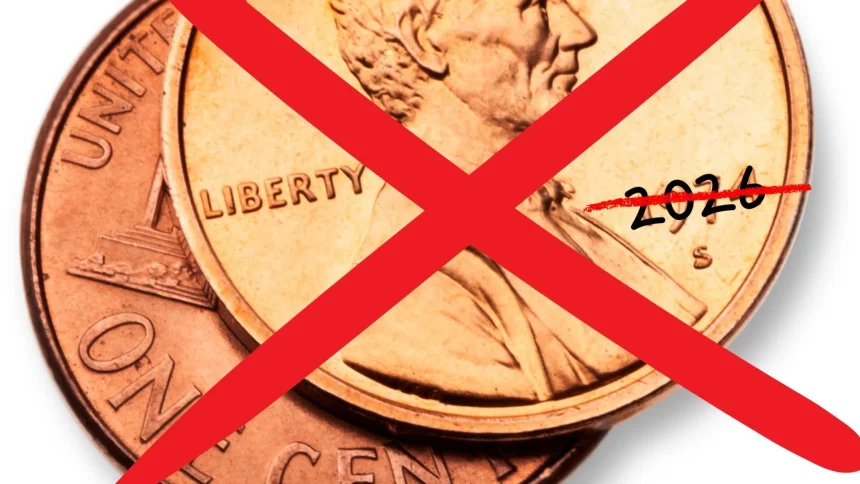The American penny officially took its final bow today — ending a 238-year run that began with Benjamin Franklin and stretched through centuries of change.
The last-ever penny was minted Wednesday afternoon at the U.S. Mint in Philadelphia, under the watchful eye of U.S. Treasurer Brandon Beach. It marked the end of an era for America’s smallest coin — once a symbol of thrift, now more of a nuisance in junk drawers.
President Donald Trump had announced in February that he’d ordered the Mint to stop producing pennies, calling the coin too expensive to make. Each penny costs nearly four cents to produce — more than its actual value.
Once prized for buying penny candy, feeding parking meters, or jingling in kids’ pockets, the coin had long since fallen out of daily use.
Beach confirmed that the final batch will be auctioned to collectors, while the last pennies sent into circulation were struck back in June.
The penny outlived its sibling, the half-penny, by 168 years. It’s survived by the nickel, dime, quarter, and the seldom-seen half-dollar and dollar coins. Despite the halt in production, all pennies will remain legal tender.
Retailers Scramble as the Penny Disappears
The decision to retire the penny was expected — but the fallout has been messier than anticipated.
Stores across the country are now trying to figure out what to do without the little copper coin. Some plan to round prices to the nearest nickel, while others are asking shoppers to pay with exact change to keep transactions smooth.
But that’s proving tricky. In some states, rounding up or down can run afoul of consumer protection laws.
And while the government hopes to save money, it may end up spending more. Producing extra nickels — which cost even more to mint than pennies — could offset any savings.
“It’s been a bit chaotic,” said Mark Weller, executive director of Americans for Common Cents, a pro-penny organization. “By Christmas, we’ll really start seeing issues with retailers not having pennies.”
Weller criticized the rollout, saying that other countries like Canada, Australia, and Switzerland planned carefully before dropping low-value coins. “We got a tweet during the Super Bowl, but no real plan,” he said, referring to Trump’s social media announcement.
How Stores Are Adapting
Some retailers are taking matters into their own hands.
Kwik Trip, a family-owned convenience store chain in the Midwest, has decided to round down cash purchases rather than charge customers more.
“There’s no way we wanted to charge people extra,” said company spokesperson John McHugh. “It’s not their fault there’s a penny shortage.”
Still, the decision comes at a cost — up to $2 million a year in lost revenue, since 17% of Kwik Trip’s 20 million customers pay in cash.
Consumers will feel a pinch, too. According to a Federal Reserve Bank of Richmond study, rounding to the nearest nickel could cost Americans an extra $6 million annually — or about five cents per household.
But even that small change isn’t universal.
Four states — Delaware, Connecticut, Michigan, and Oregon — along with several major cities, including New York, Philadelphia, Miami, and Washington, D.C., still require merchants to provide exact change.
That’s created problems for businesses and government programs alike. For instance, SNAP (the federal food assistance program) mandates that recipients pay the precise amount owed. If stores round down for cash-paying customers but not for SNAP users, they could face legal penalties.
“Rounding down sounds simple, but it opens a can of worms,” said Jeff Lenard of the National Association of Convenience Stores. “We need clear legislation to let retailers make fair change.”
The group and others have already sent letters to Congress urging lawmakers to step in.
A Long and Storied Life Comes to a Close
The penny was one of America’s first coins, first minted in 1787 — six years before the U.S. Mint even existed.
Benjamin Franklin designed the original version, known as the “Fugio cent.” The familiar Lincoln penny arrived in 1909, marking the 100th anniversary of Abraham Lincoln’s birth — and the first time a U.S. president appeared on a coin.
Over the years, the penny became less useful but more sentimental. Today, roughly 300 billion pennies remain in circulation — worth less than $9 per person — though most are sitting forgotten in jars and drawers.
For many Americans, the end of the penny is nostalgic but not heartbreaking.
Joe Ditler, a 74-year-old historian from Colorado, still keeps a cigar box of pennies passed down from his grandfather. He remembers flattening them on railroad tracks and pressing them into souvenirs at amusement parks.
“They bring back memories that have stayed with me all my life,” he said. “The penny has had a wonderful life. But it’s probably time for it to go away.”









